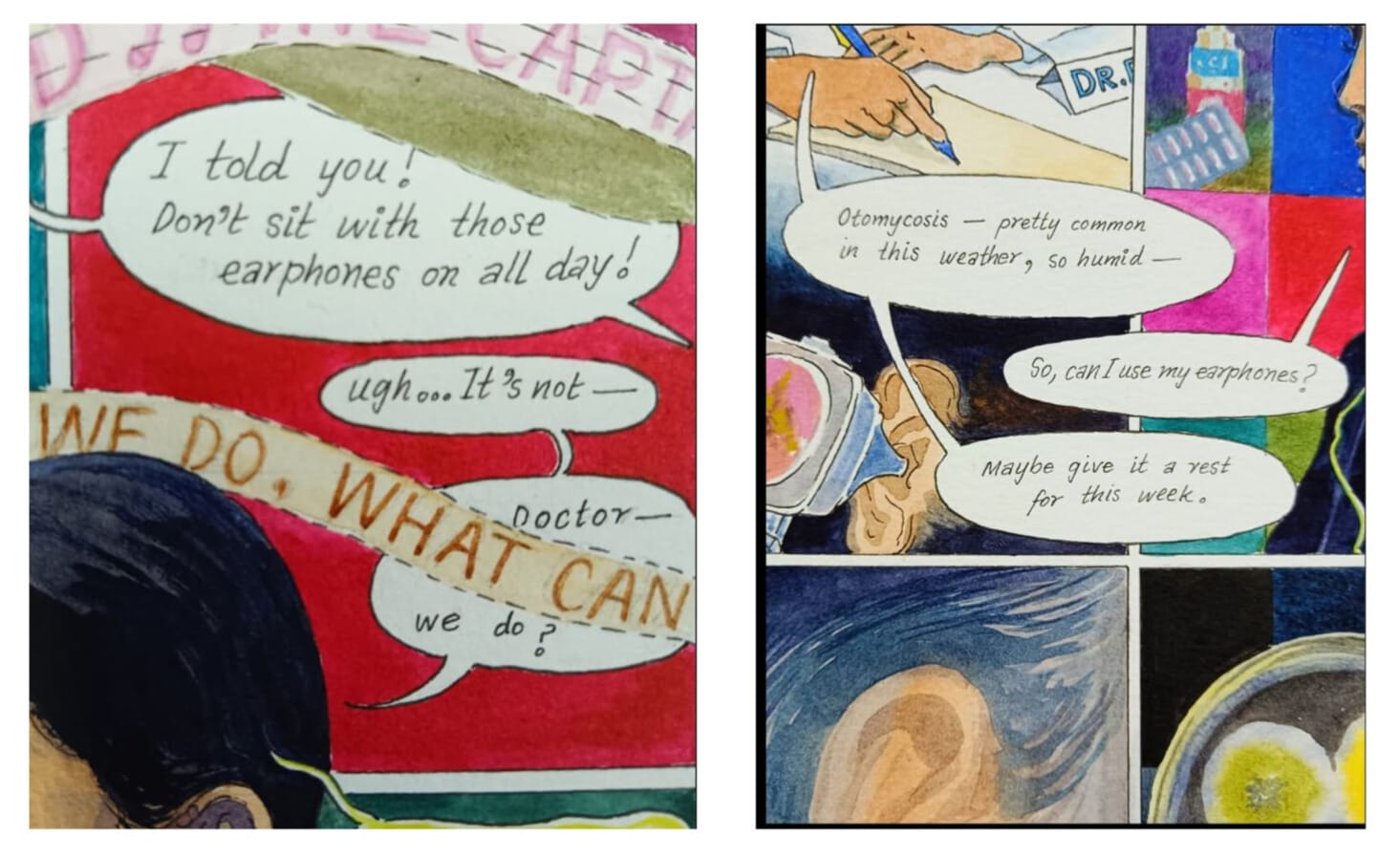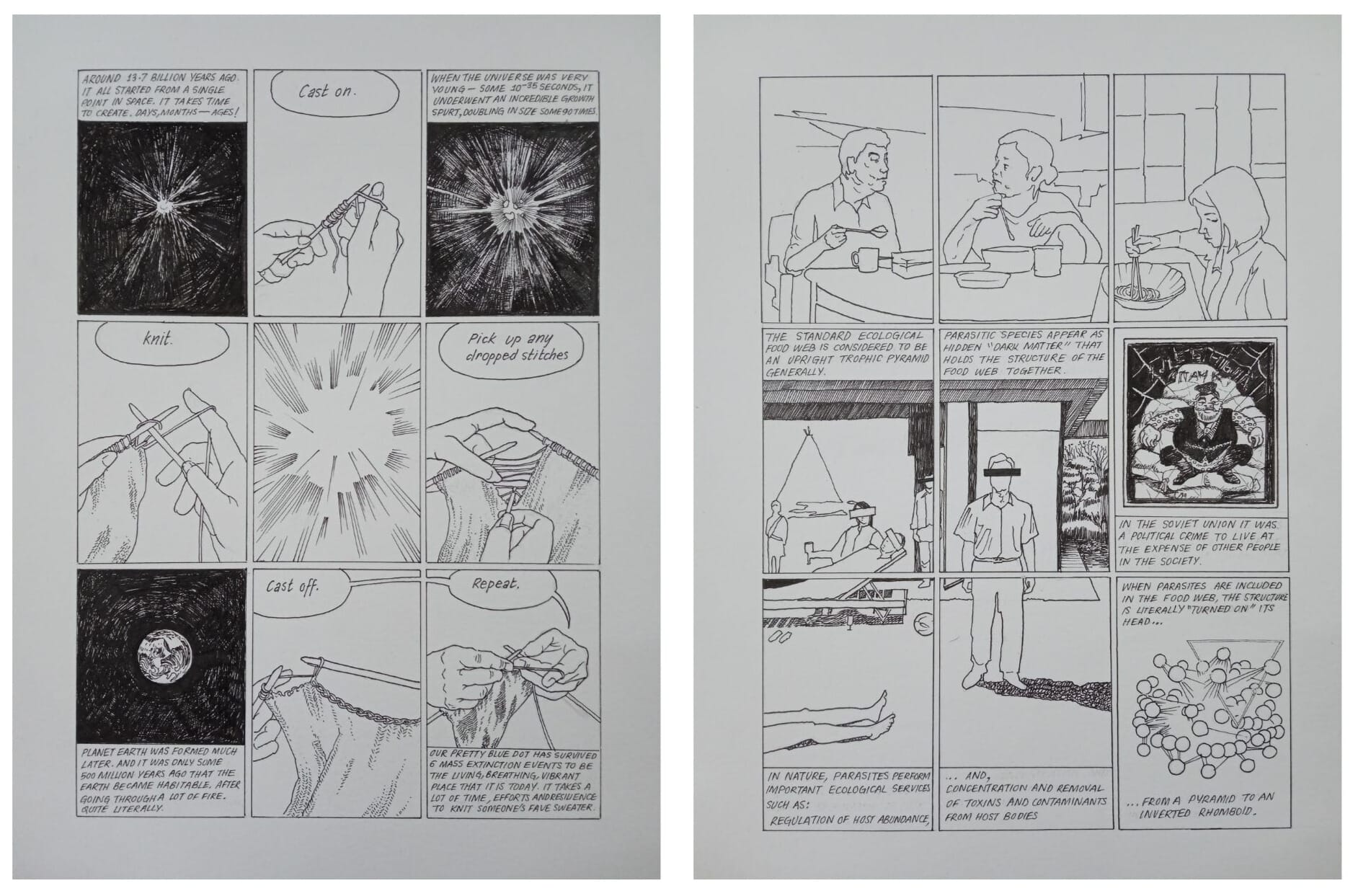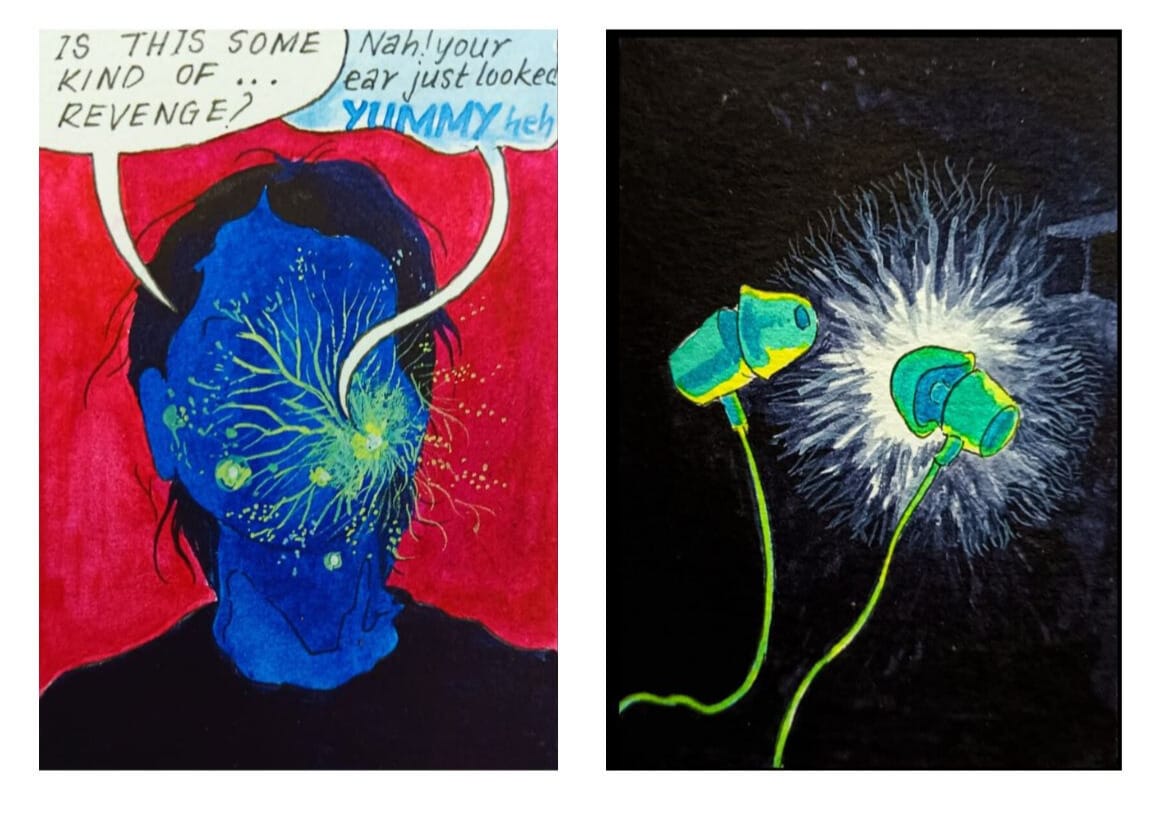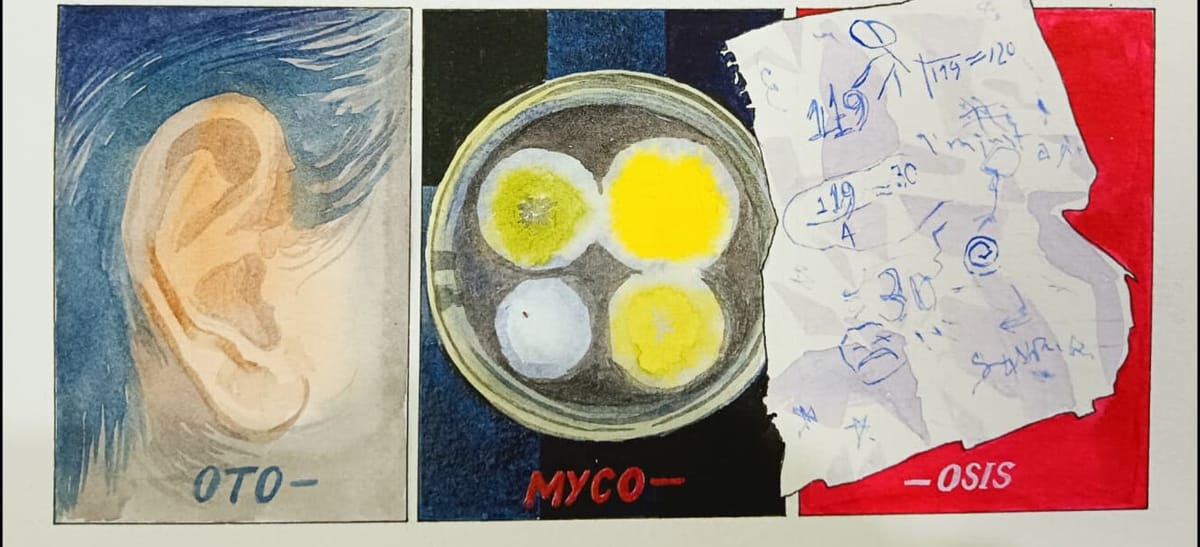It was the summer of 2024 when Pratyasha, a fifth year undergraduate student pursuing the dual B.Tech- Bio Tech degree from IIT Kharagpur, got a severe fungal infection in her ear, leading to temporary hearing loss in one ear.
Pratyasha who had pursued a remote internship under Dr Pedro Gonçalves — then a visiting assistant professor at the National Cheng Kung University in Taiwan — had begun reading on pathogenic fungi, and how fungal infections were becoming more common due to climate change as warmer climates allowed them to thrive.
With the mind of a scientist and heart of an artist, Pratyasha, facing a creative block while working on the comic, used the illness to her advantage, converting the ear infection caused due to Aspergillus fungus into a 15-page comic on fungi, with a fungal spore as the protagonist.
“The storyline is based on my own experience. The main character — the spore of the Aspergillus fungus — starts like an ear infection and takes over my brain and then the story unfolds,” she said, adding, “I wanted to tell the story from the point-of-view of the fungus because I believe that humans are no one to decide what species deserve to be saved and conserved,” she said in an interview with In Old News.
Sharing her art-work on Instagram she wrote, “The second best way of listening to metal is blasting it straight inside your ears. My lovely earphones do the trick perfectly but some Aspergillus sp [species] fellows enjoyed headbanging to CODE MISTAKE and Kingslayer on repeat as much as me and set up a moshpit inside my left ear. As a warm and accommodating host I stayed deaf in one ear for a good part of this summer. But they overstayed their welcome so I had to yeet them out with antifungals.
Moral of the story: Ear infections are common in our climate so mom is wrong, you don't need to give up on earphones. Also, clean them sometimes until you save up enough for headphones :)”

“Fungi are the perfect symbolism of how much we do not know. They are omnipresent but highly overlooked,” she said to ION.
Pratyasha, who wants to take her work on fungi further, says that while this 15-page comic was not enough to delve into all the topics she had explored during her research — including the impact of climate change on fungi — the first attempt is something that has gotten the ball rolling for her, laying the groundwork for her future works.
Talking about her research and the importance of fungi for the whole ecosystem and the negative connotations that keep them devoid of attention she says, “I want to make fungi cool again.”
Fungi as a kingdom of classification are still understudied with the State of the World’s Plant and Fungi 2023 report highlighting that of the 250 thousand to 19 million species of fungi found across the world, only 155 thousand have been identified.
The report confirms that although fungi are crucial to nearly all life on Earth — playing a vital role in supporting land plants, shaping ecosystem functions, and sustaining humanity as a whole — they often go unnoticed.
“More than 90% of fungal species remain unknown to science”, the report states, adding, “At the current rate that scientists are naming species, it would take 750–1,000 years to fully describe the world’s fungi.”
Pedro, now a principal scientist at VTT-Technical Research Centre of Finland, affirms that Mycology (the science of studying fungi) is perhaps a sort of underground or outsider subject in the broader realm of Biology. He says that even from his interactions with students of microbiology, he could observe that fungi weren’t the hottest topic of choice among them.
Fungi in want of media limelight
Fungi have typically been devoid of media attention, maybe because of their negative perception of being associated with decay, or maybe because they have been understudied in comparison to other microbes.
But these negative connotations are fairly new, say Pedro and Pratyasha who have researched the subject to find how fungi were considered sacred in many ancient cultures, often regarded as serving the bridge between humans and a higher power.
But Pedro feels that different mediums of entertainment, like movies, documentaries, TV shows etc are getting on the fungus bandwagon. He says that fungi becoming mainstream can be proven.
“Turn on a streaming platform and you will find documentaries on fungi and their indispensable role in carbon cycling and as sources of antibiotics; there is even a blockbuster show on a fungal pandemic,” he said, referring to the famous OTT series The Last of Us.
Pratyasha added, “The Last of Us did make some ripples but again it showed fungi in a negative light. We need more creative ways to talk about fungi in a manner that allows the public to understand their importance.”
Fungi play a vital role in the ecosystem but since they are understudied, the impact of climate change and rising temperatures on various fungi is also being overlooked.

Sharing his concerns, Pedro said that climate change has been leading to an alteration of the geographical distribution of some fungi, which may disrupt the whole One Health balance, that proposes that the health of people is closely related to the health of our environment, which includes all plants, animals and fungi.
“There is some evidence that previously non-pathogenic fungi may have switched to an infectious lifestyle in recent years because climate change has led to environmental conditions that allowed them to adapt to higher temperatures, hence driving the ability to grow at human body temperatures,” he shared.
With Pratyasha showing an inclination towards studying fungi, he said that their conversations delved into the subject of fungal conservation, and the utilization and overexploitation of fungi in folk medicine, subsequently leading to an article on the subject carried by The Microbiologist in December 2024.
Studies show that global trade in fungi (mostly macroscopic fungi), has increased by 15% annually in the last decade.
Some examples of overexploited fungi include the caterpillar fungus (Ophiocordyceps sinensis) - used in traditional medicine as an aphrodisiac - that has declined 30% in the Himalayas over 15 years due to overharvesting for trade. Even matsutake mushrooms in China (Tricholoma matsutake) — known for their anti-aging properties and unique taste — have suffered due to destructive collection practices and overharvesting.
The study on the state of the world’s plants and fungi states that of all the fungi present, only 625 fungi have been assessed for the International Union for Conservation of Nature (IUCN) Red List of Threatened Species. Of this, 352 (56%) are considered to be globally threatened or near threatened.
“This means that only 0.4% of the fungi described to date have had their global conservation status assessed – equating to 0.02% of those estimated to exist,” the report reads, underscoring the scale of the challenge in conserving fungi.
In the meanwhile, having read up on various kinds of fungi while undergoing treatment, Pratyasha realised that unlike other life forms, fungi were generally seen in a negative light. This inspired her to make art that could help start a dialogue about fungi and their ecological role.
“Pratyasha had already unveiled her talent for the arts and, in my memory, combining her artistic creativity and her interests in environmental justice was almost instinctive,” said Pedro, speaking about the coming together of the idea.
While comics based on science, like Manga Guide to the Universe, Science Comics etc are very popular, fungi as a subject are still left behind many-a-times because they are “not necessarily attractive enough to deserve their own comic books,” Pratyasha says.
To help her explore the age-old medium of storytelling, she approached Argha Manna, a noted researcher and comic artist who walked her through the art of storytelling through comics and lent her several classics like Maus, Meta Maus and Watchmen to get her started.

“Pratyasha came from IIT Kharagpur to IIT Gandhinagar to do an internship. But I found she already had a good skill of drawings and an innate nature of storytelling. So, I just asked her to go through a couple of good comics to acclimatize in this media along with whatever she has done on her own,” said Argha.
Argha says he approaches comics as a researcher first, until the story comes to his mind and he starts seeing visuals that he wants to sketch, and only then does he begin drawing.
“I do a lot of research before I draw comics already, I dig out unknown facts, I explore unexplored possibilities - the final material appears to be a very engaging one to a larger audience,” he added.
Pratyasha, who was new to the medium of comics, added that along with her research on fungi, she also had to study the medium before starting out. She dove into the classics lent to her by Manna.
“It was then that I discovered how sophisticated the medium of comics was,” she said.
Pratyasha has also drawn references from Rock Music and various studies, articles and reports on fungi and climate change to weave the storyline of her comic.
“The personal significance of this infection is that it interfered with my favourite pastime - listening to music, especially Rock, so I decided to turn that into an artistic motif. Rock as a genre has a fair bit of activism including climate conscious lyrics by greats like Paul McCartney; early on in the story there is a reference to his song Despite Repeated Warnings. Once the comic was made, I continued working on the article that had been in limbo all this while because I realised that fungi deserve to have their story told in as many ways as possible.”
The comic will be published by a noted publisher as part of an anthology soon.
Engaging citizen scientists in a love for mycology
Many institutes like The Microbe Institute’s initiative called The Global Lichen Hunt and The University of Tarut’s FunLeaf project are encouraging citizens worldwide to document microbial biodiversity in their neighbourhood.
Pedro further told ION that a recent article by a group of authors in a journal from The Society for Conservation Biology has highlighted the importance of citizen science-based projects in filling this knowledge gap about fungi and developed a dichotomous key for mycologists to decide how their projects can benefit from the contribution of the public community at large.
“The scarcity of sufficiently trained field personnel is still an issue that cannot be fully compensated by citizen science alone. Perhaps this is where organisations like the Society for the Protection of Underground Networks (SPUN) can pitch in with a dedicated global network of field specialists supplemented by youth awareness programs,” he added.
He further said that IUCN has been maintaining a list of “Amazing Species” as an initiative “to increase awareness of the enormous variety of life on our planet and raise the profile of the threatened species” since 2011.
Out of the 561 species currently listed by IUCN as “Amazing Species”, 459 are animals, 99 are plants and a mere three are fungi.
The list includes plants like Café marron, Dragon blood tree, Arnica des montagnes to name a few, animals like Turtle head seasnake, Grand Cayman Blue iguana, Takin, etc and three fungi - Chinese Caterpillar Fungus and Nail Fungus and Erioderma pedicellatum, the fungal partner in Boreal felt lichen. A lichen (a symbiotic combination of fungus and algae or cynobacteria), but they are traditionally named after their primary fungal partner.
“This is good, but still only a start,” Pedro said.

